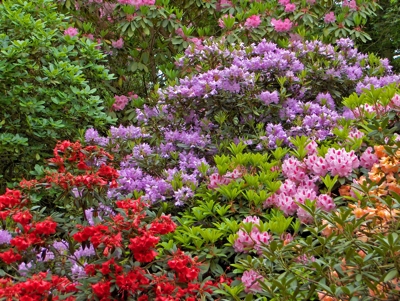Growing Rhododendrons and Azaleas
A bank of rhododendrons or azaleas in spring is truly a beautiful sight, and one that is familiar to many of us from visits to stately homes and gardens. But growing rhododendrons and azaleas is not difficult, even in small gardens, provided that you can meet certain requirements.
 Rhododendrons and azaleas are ericaceous plants. Although their requirements are not as extreme as blueberries, for example, they still need acidic soil, with a pH of about 6 or less. But even if you don’t have acidic soil, you can either grow them in the garden and add an acidifier periodically, or you can grow them in containers.
Rhododendrons and azaleas are ericaceous plants. Although their requirements are not as extreme as blueberries, for example, they still need acidic soil, with a pH of about 6 or less. But even if you don’t have acidic soil, you can either grow them in the garden and add an acidifier periodically, or you can grow them in containers.
Growing in the garden
If you have really alkaline soil, it’s probably not worth trying to grow azaleas or rhododendrons in the garden. But if your soil is around ph7, you can probably get away with it. To acidify your soil, add iron sulphate around the base of your rhododendron, or where you want to plant it. You will need to reapply from time to time, so buy a soil testing kit, and test periodically to see if you need to add more. It’s best not to wait until your plants are looking peaky before reapplying!
Growing in pots
There are plenty of dwarf rhododendrons and azaleas that will be very happy growing in pots, in good ericaceous compost, which is available from garden centres and compost suppliers. Look out for R. yakushimanum hybrids, and in particular a series named after the Seven Dwarfs: Grumpy, Dopey and so on. These will form compact bushes about 2ft by 2ft, given space in a large tub, and flower reliably. Smaller azaleas are also available, both deciduous and evergreen, which can be grown in smaller tubs, or together in a larger half-barrel or similar big pot, for impact.
General care
Apart from the requirement for ericaceous compost, rhododendrons are generally quite easy. They’ll need watering, of course, especially in containers, and if possible, you should water with rainwater, as tap water is a bit too alkaline. And the other chore that is pretty much essential if you want them to flower each year is deadheading. If you don’t deadhead, they seem to flower only every other year, so it’s well worth sitting down with a small pair of secateurs or scissors once the flowering season is over, and gently snipping off all the old flowerheads. Be careful not to cut the new leaves that will be growing behind and around the old flowers; the best way to avoid this problem is to deadhead promptly after flowering.
Finally, if your plants show signs of looking a bit sad, try applying an ericaceous fertiliser, and don’t forget to repot container-grown plants every couple of years at least.